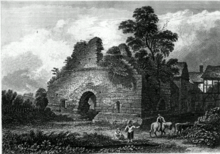Castles of England/Greater Manchester
There are two castles of note in Greater Manchester.
| Name |
Type |
Date |
Condition |
Ownership / Access |
Notes (Key) |
|---|---|---|---|---|---|
| Buckton Castle | Ringwork | 12th century | Earthworks | Situated on Buckton Moor, 335m above sea level, hilltop. | |
| Radcliffe Tower | Tower house | 1403 | Fragment | Local authority |
Buckton Castle
[edit | edit source]
Buckton Castle is a medieval enclosure castle near Carrbrook, Stalybridge. The castle is oval, with a 3m wide stone curtain wall surrounded by a 10m wide, 6m deep ditch. It is uncertain who built the castle, but it may have been constructed for the early of Chester in the 12th century; it was lying derelict by 1360 when it was first mentioned in historical sources. The small number of finds retrieved during archaeological investigation of the site indicates that Buckton Castle may not have been completed.
The castle stands 335m above sea level on Buckton Hill, a steep sandstone ridge. The castle's positioning may have been to allow its garrison to guard the Tame Valley; both castle and valley were in the medieval manor of Tintwistle.

The entrance to the ringwork is to the northwest of the site. On the south-facing side of the site are the remains of a stone curtain wall. The north-west entrance was protected by a stone gatehouse; the wall thickness suggests the tower was probably two storeys high.
The interior of the castle is artificially raised 1.5m above ground level. According to a 1360 survey of property in Longdendale, Buckton Castle may have had a hall and a chapel. In the 18th century, antiquarian Thomas Percival recorded a well within the castle, and walls of buildings inside the castle still standing to a height of 2m. However, these features were no longer obvious when Ormerod wrote about the castle in 1817, and have not been discovered by archaeological excavations.
The castle is now overgrown with heather and peat, and there are no above-ground ruins.
Radcliffe Tower
[edit | edit source]

Radcliffe Tower is the only surviving part of a manor house in Radcliffe, Greater Manchester. The house was rebuilt in 1403 by James de Radcliffe, who was lord of the manor of Radcliffe, and consisted of a stone-built hall and one or two towers, probably built with ashlar blocks. De Radcliffe was given a royal licence to fortify the site including adding crenellations and battlements.
The manor house was demolished in the 19th century leaving only the tower. The tower measures 10.5 yards by 19 yards and survives to about 20 feet in height.
